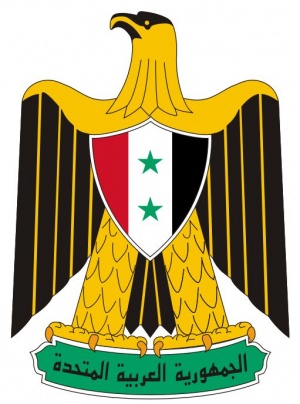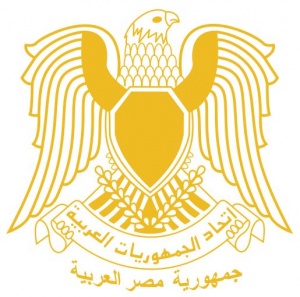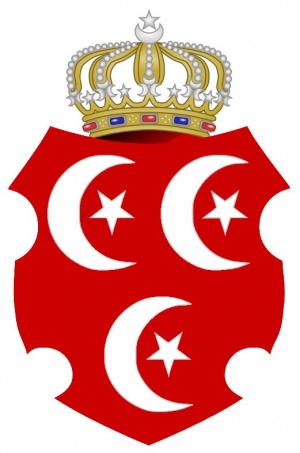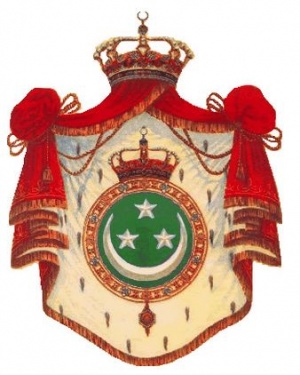National Arms of Egypt: Difference between revisions
Knorrepoes (talk | contribs) (Created page with '{|width="100%" style="color:black; background-color:#ffffcc;" |width="15%"|50 px|left |width="70%" align="center" |'''Heraldry of the World<br>Civic heraldry o…') |
Knorrepoes (talk | contribs) m (Text replace - "[[Literature" to "{{media}} [[Literature") |
||
| (3 intermediate revisions by the same user not shown) | |||
| Line 9: | Line 9: | ||
[[File:Egypt.jpg|center]] | [[File:Egypt.jpg|center]] | ||
====Origin/meaning==== | |||
The arms were adopted | The arms were adopted in 1984. | ||
Egypt does not have a proper coat of arms, but uses a State Symbol with the Eagle of Saladin, holding a small shield with the flag on its breast. The eagle stands on a scroll with the name of the country in Arabic. | |||
The | The Eagle of Saladin appeared as the main symbol of Egypt after the revolution of 1953. | ||
Initially the eagle held a round shield with the previous coat of arms, but in 1958, the shield was replaced by the flag and the name of the country was added to the base. From 1972-84 a non coloured state logo was used. | |||
The arms | {|align="center" | ||
|align="center"|[[File:egypt1953.jpg|center|300 px]] <br/>The arms from 1953-1958 | |||
|align="center"|[[File:egypt1958.jpg|center|300 px]] <br/>The arms from 1958-1971 | |||
|align="center"|[[File:egypt1972.jpg|center|300 px]] <br/>The arms from 1972-1984 | |||
|} | |||
The first proper use of a coat of arms was in 1914 when the new Sultanate of Egypt under British protection adopted the arms below. The Sultanate was replaced by the independent Kingdom of Egypt in 1922 and the royal arms have been in use until 1953. | |||
The arms of the Sultanate and the Kingdom showed the crescent of Islam and three stars. | |||
{|align="center" | |||
|align="center"|[[File:egypt1914.jpg|center|300 px]] <br/>The arms from 1914-1922 | |||
|align="center"|[[File:egypt1922.jpg|center|300 px]] <br/>The arms from 1922-1953 | |||
|} | |||
{{media}} | |||
[[Literature]] : - | [[Literature]] : - | ||
Revision as of 02:02, 9 July 2014
| Heraldry of the World Civic heraldry of Egypt |
NATIONAL COAT OF ARMS OF EGYPT
Origin/meaning
The arms were adopted in 1984.
Egypt does not have a proper coat of arms, but uses a State Symbol with the Eagle of Saladin, holding a small shield with the flag on its breast. The eagle stands on a scroll with the name of the country in Arabic.
The Eagle of Saladin appeared as the main symbol of Egypt after the revolution of 1953.
Initially the eagle held a round shield with the previous coat of arms, but in 1958, the shield was replaced by the flag and the name of the country was added to the base. From 1972-84 a non coloured state logo was used.
| The arms from 1953-1958 |
The arms from 1958-1971 |
The arms from 1972-1984 |
The first proper use of a coat of arms was in 1914 when the new Sultanate of Egypt under British protection adopted the arms below. The Sultanate was replaced by the independent Kingdom of Egypt in 1922 and the royal arms have been in use until 1953. The arms of the Sultanate and the Kingdom showed the crescent of Islam and three stars.
| The arms from 1914-1922 |
The arms from 1922-1953 |
Contact and Support
Partners:
Your logo here ?
Contact us
© since 1995, Heraldry of the World, Ralf Hartemink 
Index of the site
Literature : -
















